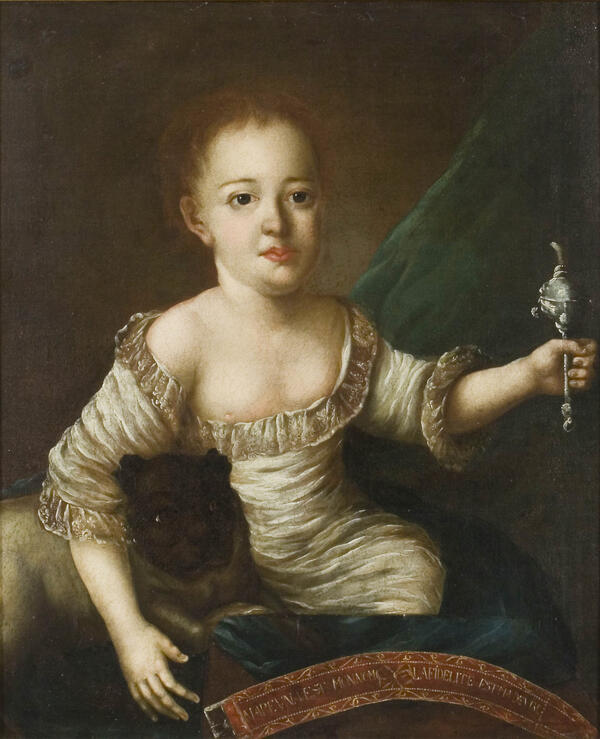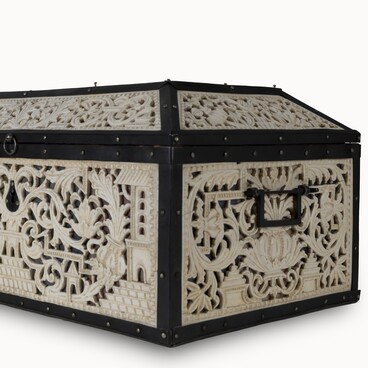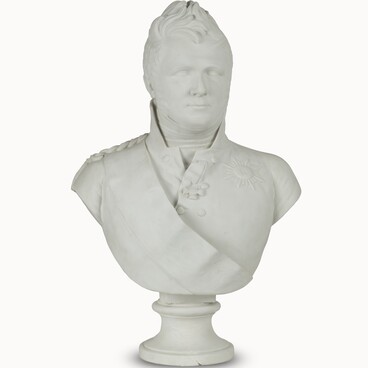Museum collections, as a rule, consist not only of masterpieces, but also of works that form a multicolored, comprehensive understanding of the artistic development of the country, reflecting the aesthetics of a certain era. The time of the “great metamorphosis” — as contemporaries called Peter the Great’s epoch — was the time when Russian art was introduced to the European artistic traditions. New forms and genres arose and developed. However, the main genre throughout the 18th century was the portrait.
Among the early works in the collection of the National Art Museum of the Sakha Republic is the portrait “A Boy with a Rattle”, created by an unknown artist in the middle of the 18th century. Similar portraits once adorned private collections of numerous provincial estates. Most likely, this is the firstborn — the heir to the family name and property. This is indicated by the motto featured on the canvas, which can be in part translated as “My name is loyalty.” It was probably written by an artist who did not speak the language.
A seemingly insignificant detail indicates that the boy comes from a noble family: the image of the most fashionable dog of the mid-18th century — a pug. The elements of the archaic parsuna, an early genre of portrait, are still visible in this picture: the immobility and conventionality of the pose and gesture, the accentuated silhouette of the figure, as well as the inability to convey age characteristics, as the child appears to the viewer as a “tiny adult”. At the same time, the artist is clearly familiar with the “scholarly”, European art. Properly applied highlights enliven the look of the boy’s eyes and convey the texture of metal. The face is modeled in a peculiar way with a smooth transition from light to shadow. In the solemnly opened curtain, the faded background behind the image of the boy is an attempt to create the depth of space.
In the work of the provincial artist, old traditions merge with the language of new art. Thus, the nameless portrait shows us a complex mixture of old and new techniques characteristic of the transitional period in the development of the Russian portrait and its manor culture, where this tradition remained viable for a long time.
Among the early works in the collection of the National Art Museum of the Sakha Republic is the portrait “A Boy with a Rattle”, created by an unknown artist in the middle of the 18th century. Similar portraits once adorned private collections of numerous provincial estates. Most likely, this is the firstborn — the heir to the family name and property. This is indicated by the motto featured on the canvas, which can be in part translated as “My name is loyalty.” It was probably written by an artist who did not speak the language.
A seemingly insignificant detail indicates that the boy comes from a noble family: the image of the most fashionable dog of the mid-18th century — a pug. The elements of the archaic parsuna, an early genre of portrait, are still visible in this picture: the immobility and conventionality of the pose and gesture, the accentuated silhouette of the figure, as well as the inability to convey age characteristics, as the child appears to the viewer as a “tiny adult”. At the same time, the artist is clearly familiar with the “scholarly”, European art. Properly applied highlights enliven the look of the boy’s eyes and convey the texture of metal. The face is modeled in a peculiar way with a smooth transition from light to shadow. In the solemnly opened curtain, the faded background behind the image of the boy is an attempt to create the depth of space.
In the work of the provincial artist, old traditions merge with the language of new art. Thus, the nameless portrait shows us a complex mixture of old and new techniques characteristic of the transitional period in the development of the Russian portrait and its manor culture, where this tradition remained viable for a long time.



